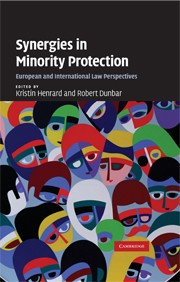Book contents
- Frontmatter
- Contents
- Foreword
- Abbreviations
- 1 Introduction
- PART A Minorities-specific instruments, provisions and institutions
- 2 The United Nations International Covenant on Civil and Political Rights: Article 27 and other provisions
- 3 The United Nations Working Group on Minorities
- 4 The OSCE High Commissioner on National Minorities
- 5 The Council of Europe's Framework Convention for the Protection of National Minorities
- 6 The Council of Europe's European Charter for Regional or Minority Languages
- PART B Non-minorities-specific instruments, provisions and institutions
- Index
- References
5 - The Council of Europe's Framework Convention for the Protection of National Minorities
from PART A - Minorities-specific instruments, provisions and institutions
Published online by Cambridge University Press: 21 July 2009
- Frontmatter
- Contents
- Foreword
- Abbreviations
- 1 Introduction
- PART A Minorities-specific instruments, provisions and institutions
- 2 The United Nations International Covenant on Civil and Political Rights: Article 27 and other provisions
- 3 The United Nations Working Group on Minorities
- 4 The OSCE High Commissioner on National Minorities
- 5 The Council of Europe's Framework Convention for the Protection of National Minorities
- 6 The Council of Europe's European Charter for Regional or Minority Languages
- PART B Non-minorities-specific instruments, provisions and institutions
- Index
- References
Summary
Introduction
The Council of Europe's Framework Convention for the Protection of National Minorities (‘FCNM’) was adopted in 1994 and entered into force in 1998. Article 1 of the FCNM proclaims that: ‘The protection of national minorities and of the rights and freedoms of persons belonging to those minorities forms an integral part of the international protection of human rights, and as such falls within the scope of international co-operation’. The purpose of this chapter is to show, from the monitoring practice, several implications of that assertion: (1) the interpretation and application of the FCNM draws on the basic principles underlying universal human rights, including that human rights are for everyone and are therefore different from citizens' rights, and that they shall be ensured without discrimination; (2) earlier usages of the concept of minorities, derived from practices before 1945 when human rights were made part of the emerging international law of cooperation, are invalid to the extent that they conflict with contemporary human rights; (3) while the FCNM reaffirms the applicability of standard human rights to persons belonging to minorities, it goes beyond that by providing additional rights for such persons and by imposing obligations on the state to protect the minorities as groups.
The term ‘standard human rights’ refers to the rights contained in the Universal Declaration of Human Rights and in the global and regional conventions derived from that declaration.
- Type
- Chapter
- Information
- Synergies in Minority ProtectionEuropean and International Law Perspectives, pp. 119 - 154Publisher: Cambridge University PressPrint publication year: 2009
References
- 3
- Cited by

